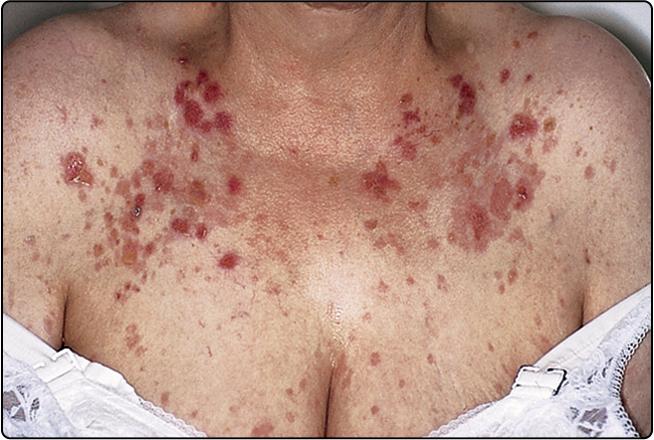Physical Address
304 North Cardinal St.
Dorchester Center, MA 02124
Blistering is often seen with skin disease. It is found with common dermatoses such as acute contact dermatitis, pompholyx, herpes simplex, herpes zoster and bullous impetigo, and it also occurs after insect bites, burns and friction or cold injury. The type of blister depends on the level of cleavage: subcorneal or intraepidermal blisters rupture easily, but subepidermal ones are not so fragile ( Fig. 44.1 ). The primary acquired autoimmune bullous disorders, dealt with here, are rare but important and diagnosis is predominantly based around direct immunofluorescence (p. 162) but newer ELISA-based assays are proving useful.
Pemphigus is an uncommon, severe and potentially fatal autoimmune blistering disorder affecting the skin and mucous membranes.
Over 80% of patients have circulating immunoglobulin (Ig) G autoantibodies, detectable in the serum by indirect immunofluorescence (p. 162), which bind with desmoglein, a desmosomal cadherin involved in epidermal intercellular adhesion. The antibodies, possibly with complement activation and protease release, result in loss of adhesion and an intraepidermal split. Direct immunofluorescence shows the intercellular deposition of IgG in the suprabasal epidermis. Pemphigus is associated with other organ-specific autoimmune disorders such as myasthenia gravis.
In Europe, pemphigus is much less common than pemphigoid, and tends to affect middle-aged or young adults. Oral erosions signal the onset of pemphigus vulgaris in 50%–70% of patients and often precede cutaneous blistering by months. Flaccid superficial blisters develop over the scalp, face, back, chest and flexures. The blistering is not always obvious, and lesions may consist of crusted erosions. Untreated, the blistering is progressive and, prior to the introduction of steroids, three out of four patients died within 4 years, usually from uncontrolled fluid and protein loss or secondary infection.
Less common variants include pemphigus foliaceus , in which shallow erosions appear on the scalp, face and chest ( Fig. 44.2 ), and pemphigus vegetans , in which pustular and vegetating lesions affect the axillae and groins. In Brazil, an endemic form of pemphigus foliaceus, fogo selvagem , seems to be induced by an infective agent. Paraneoplastic pemphigus describes a variant associated with underlying malignancy.

Aphthous ulcers or Behçet’s disease can simulate the oral erosions of pemphigus. Cases with rapid onset need to be differentiated from toxic epidermal necrolysis. Widespread skin erosions may suggest epidermolysis bullosa or pemphigoid. The diagnosis relies on the histological examination of a bulla and direct immunofluorescence.
Become a Clinical Tree membership for Full access and enjoy Unlimited articles
If you are a member. Log in here